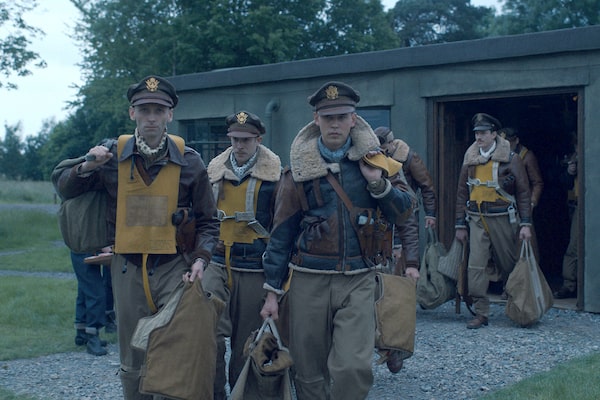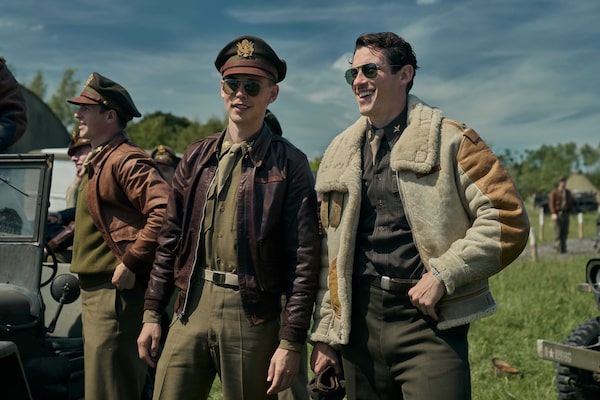
Austin Butler and Edward Ashley in Masters of the Air, premiering Jan. 26, on Apple TV+.Supplied
The Second World War continues to be recreated over and over on our screens, year after year – so how come society’s real historical knowledge and understanding of that conflict seems to be on the decline, aiding and abetting our slip toward a sequel?
Despite a steady diet of D-to-VJ day dramatizations big and small (two new ones were just nominated for Best Picture at the Oscars), Americans, at least, are falling into a memory hole about what matters about the Second World War. A recent poll found one in five Americans aged 18 to 28 agreed with the statement “the Holocaust is a myth.” Then you’ve got an aspiring American authoritarian like Ron DeSantis ending his presidential campaign this week by quoting Winston Churchill (well, misquoting Churchill as it turned out).
No doubt, executive producers Tom Hanks and Steven Spielberg think they’re fighting historical amnesia – on the couches, on the smartphones, on the long-haul airplane flights – with their series of miniseries about Americans in the Second World War: First Band of Brothers and The Pacific a decade or two ago on HBO, and now Masters of the Air, a new nine-part series about the American bombers of “the bloody hundredth” that cost an estimated US$250-million to make and drops its first two episodes on Wednesday on Apple TV+.
But I’m not so sure. Based on the first two episodes of their latest sortie, this is the exact sort of blinkered big-budget, small-picture portrait of the war that skews understanding of the global conflict with an overly American POV – zeroing in on fresh-faced boys about to ship out overseas in 1943 and then following those that survive to the end of the war.
To say Masters of the Air is myopic is not to say that it isn’t masterfully so. Created by John Shiban and John Orloff, and based on a non-fiction 2007 book of the same title, the precision focus this time around is on the men who flew B-17s with the 100th Bomb Group, a part of the United States Army Air Forces that gained that nickname “the bloody hundredth.”
The stars of the show are ostensibly Austin Butler, the luscious-lipped fellow who recently played Elvis, and Callum Turner, a British actor who’s dating Dua Lipa. They play real-life Majors Gale Cleven and John Egan, whose nicknames were Buck and Bucky, respectively, confusingly.
But despite that level of commitment to true detail even when it is really annoying, these characters seem not much more than contrasting clichés in the lazy fly-by writing – one’s a teetotaller and inscrutable, holding his pain inside; the other gets up to alcohol-fuelled high jinks after every mission to erase it. (Almost all the others characters tend to blur into one another as they speak in dialogue that often sounds generated by GI AI: “Stay with me, goddamnit!”)
The actual shining stars of the series are the planes themselves, big shaky metal buckets flown by groups of men working in teams, the pilots, the gunners, the navigator, to drop bombs on U-boats and eventually Berlin.
As a viewer, you get to intimately explore and inhabit every cramped inch of these planes’ interiors – feel the panic of trying to calculate courses in real time with a paper map before computers, and the terror of being the guy who’s down in a kind of glass bubble on the bottom as flak is fired right up toward you by anti-aircraft guns.
Masters of the Air’s aerial action sequences are edge-of-your-seat electric; with old-school True Detective’s Cary Joji Fukunaga helming the initial episodes as director, each mission is broken down in such a clear way that every flicked switch sends a frisson down your spine.
History Channel addicts will be salivating at the aforementioned attention to every tiny detail – though they might be the only ones who love the voice-over narration by airsickness-prone navigator Lt. Crosby (Anthony Boyle).

Austin Butler and Callum Turner in Masters of the Air.Robert Viglasky/Supplied
“The Americans pursued daylight precision bombing,” Crosby explains, from somewhere in the distant future, so I assume he makes it to the end alive. “The British who had been at war with the Nazis for nearly four years, practised nighttime aerial bombing; it was indiscriminate and deadly.”
A technology called the Norden bombsight – “the most closely held secret of the war” outside of the Atomic bomb, says our narrator, who must have high-level clearance – led the Americans to pursue these near-suicidal missions. Maybe later episodes will explore how this bombsight ended up not really living up to that reputation.
But, for now, the daylight versus nighttime missions are used to illustrate that supposed difference between Americans with their war-winning devil-may-care daring-do and the British with their stalemate-y caution and love of rules and queues (while the Soviets off fighting tooth-and-nail in Stalingrad are ignored, of course).
In the second episode, a cartoonishly condescending British pilot mocks the Americans and gets challenged to a fist-fight by an Irish-American character played by Barry Keoghan, the always watchable and sudden ubiquitous Irish actor, putting on a go-for-broke Yankee accent.
Where all of American let’s-roll attitude was in the almost four years before that country properly got into the Second World War is not covered in this miniseries. Go watch HBO’s The Plot Against America, which though counterfactual is more illuminating on that front.
Maybe the remaining episodes of Masters of the Air will say or show something about the war beyond the bomber bubble – but, in its initial episodes, it feels more like an expensive averted gaze from what’s going on now rather than any sort of urgent reminder of what happened.